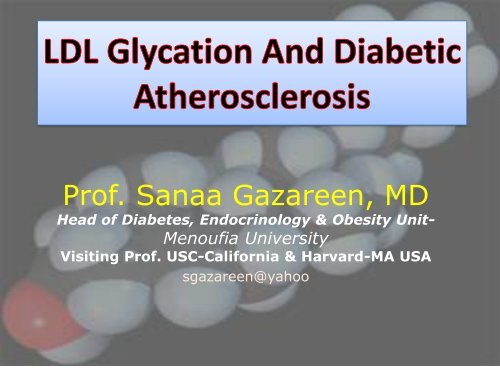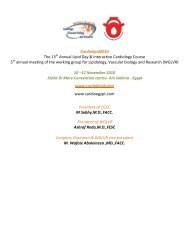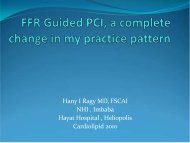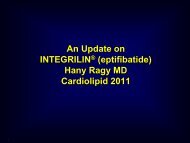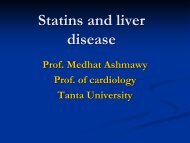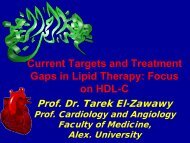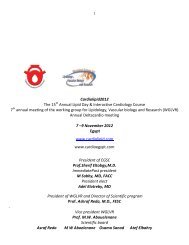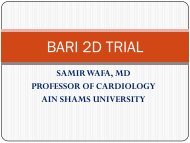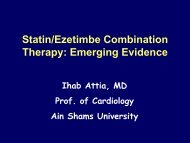Role of glycated LDL in diabetic atherosclerosis
Role of glycated LDL in diabetic atherosclerosis
Role of glycated LDL in diabetic atherosclerosis
Create successful ePaper yourself
Turn your PDF publications into a flip-book with our unique Google optimized e-Paper software.
Pr<strong>of</strong>. Sanaa Gazareen, MD<br />
Head <strong>of</strong> Diabetes, Endocr<strong>in</strong>ology & Obesity Unit-<br />
Menoufia University<br />
Visit<strong>in</strong>g Pr<strong>of</strong>. USC-California & Harvard-MA USA<br />
sgazareen@yahoo
• Patients with DM are 2-8 times more likely to<br />
experience future cardiovascular events.<br />
• <strong>LDL</strong>c is an important factor <strong>in</strong> atherogenesis.<br />
Howard BV, Rodriguez BL, Bennett PH, et al. Prevention Conference VI: Diabetes and Cardiovascular disease: Writ<strong>in</strong>g Group I:<br />
epidemiology. Circulation. May 7 2002;105(18):e132-7.<br />
Malmberg K, Yusuf S, Gerste<strong>in</strong> HC, et al. Impact <strong>of</strong> diabetes on long-term prognosis <strong>in</strong> patients with unstable ang<strong>in</strong>a and non-Qwave<br />
myocardial <strong>in</strong>farction: results <strong>of</strong> the OASIS (Organization to Assess Strategies for Ischemic Syndromes) Registry. Circulation.<br />
2000;102:1014-1019
Pathogenic mechanisms <strong>in</strong>volved <strong>in</strong> the <strong>in</strong>itiation and<br />
progression <strong>of</strong> <strong>atherosclerosis</strong> <strong>in</strong> patients with DM<br />
AGE, advanced glycation end products, CRP, C-reactive prote<strong>in</strong>; HDL, high-density lipoprote<strong>in</strong>; IL-1b, <strong>in</strong>terleuk<strong>in</strong>-1b; IL-6, <strong>in</strong>terleuk<strong>in</strong>-<br />
6; <strong>LDL</strong>, low-density lipoprote<strong>in</strong>; PAI-I, plasm<strong>in</strong>ogen activator <strong>in</strong>hibitor-I; ROS, reactive oxygen species; SAA, serum amyloid A prote<strong>in</strong>;<br />
TF, tissue factor; TG, triglycerides; tPA, tissue-type plasm<strong>in</strong>ogen activator.<br />
Bion di-Zoccai et al (2003, Journal <strong>of</strong> the American College <strong>of</strong> Cardiology
Prevalence <strong>of</strong> Dyslipidemia is high <strong>in</strong> Type 2 Diabetes<br />
Control <strong>of</strong> Lipids<br />
Patients With<br />
Diabetes, %<br />
Patients Without<br />
Diabetes, %<br />
P Value<br />
<strong>LDL</strong>-C<br />
> 100 mg/dL<br />
HDL-C<br />
< 40 mg/dL (men)<br />
< 50 mg/dL (women)<br />
Triglycerides<br />
> 150 mg/dL<br />
74.7 75.7 NS<br />
63.7 40.0 < .001<br />
61.6 25.5 < .001<br />
N = 498 adults (projected to 13.4 million) aged > or = 18 years with diabetes<br />
representative <strong>of</strong> the US population and surveyed with<strong>in</strong> the cross-sectional<br />
National Health and Nutrition Exam<strong>in</strong>ation Survey 1999-2000.<br />
Jacobs MJ, et al. Diabetes Res Cl<strong>in</strong> Pract. 2005;70:263-269.
IN DM: <strong>LDL</strong>c<br />
Rout<strong>in</strong>e LAB. Measurement <strong>of</strong> <strong>LDL</strong>?<br />
Is <strong>LDL</strong>c really a s<strong>in</strong>gle entity??
<strong>LDL</strong> Subfractions<br />
• Larger <strong>LDL</strong> subfractions (1, 2, 3) are considered type A<br />
and are less frequently associated with coronary artery<br />
disease.<br />
• Small, dense <strong>LDL</strong> subfractions (4-7, non type A) are<br />
generally considered more atherogenic. There is an<br />
<strong>in</strong>creased prevalence <strong>of</strong> non-type A <strong>LDL</strong> subfractions <strong>in</strong><br />
Type 2 diabetes and <strong>in</strong>sul<strong>in</strong> resistance syndrome 1 .<br />
lipoprote<strong>in</strong>s <strong>of</strong> > 70 nm have limited transcytosis past the<br />
endothelium<br />
1. Aust<strong>in</strong> MA, Hokanson JE, Brunzell JD. Characterization <strong>of</strong> low-density lipoprote<strong>in</strong><br />
subclasses: methodologic approaches and cl<strong>in</strong>ical relevance. Curr Op<strong>in</strong> Lipidol 1994;5:395-<br />
403.<br />
2. Younis NN, Soran H, Sharma R, et al. Small-dense <strong>LDL</strong> and <strong>LDL</strong> glycation <strong>in</strong> metabolic<br />
syndrome and <strong>in</strong> stat<strong>in</strong>-treated and nonstat<strong>in</strong>-treated type 2 diabetes. Diab Vasc Dis Res<br />
2010; 7:289–295
The primary atherogenic lipoprote<strong>in</strong> is <strong>LDL</strong> (small dense <strong>LDL</strong>)<br />
lipoprote<strong>in</strong>s <strong>of</strong> > 70 nm have limited transcytosis past the endothelium<br />
Monocyte<br />
Nascent<br />
chylomicron Nasce<br />
t V<strong>LDL</strong><br />
Vessel Lumen<br />
Adhesion<br />
Molecules<br />
Χ<br />
Χ<br />
<strong>LDL</strong><br />
Artery wall<br />
MCP-1<br />
<strong>LDL</strong><br />
Endothelium<br />
Modified <strong>LDL</strong><br />
Taken up by<br />
Macrophage<br />
Intima<br />
Foam Cell<br />
Macrophage<br />
Modified <strong>LDL</strong> is more taken by macrophages then non modified <strong>LDL</strong> Ste<strong>in</strong>berg D e<br />
al. N Engl J Med 1989;320:915-924.
Oxidized <strong>LDL</strong> pathway dur<strong>in</strong>g atherogenesis<br />
Oxidative modification <strong>of</strong> <strong>LDL</strong> has been most widely studied and is currently believed to be<br />
<strong>in</strong>volved <strong>in</strong> <strong>atherosclerosis</strong><br />
1- Mackness MI, Durr<strong>in</strong>gton PN, Mackness B. How high-density lipoprote<strong>in</strong> protects aga<strong>in</strong>st the effects <strong>of</strong> lipid peroxidation. Curr<br />
Op<strong>in</strong> Lipidol 2000; 11:383–388. 2- Ste<strong>in</strong>berg D, Parthasarathy S, Carew TE, et al. Beyond cholesterol. Modifications <strong>of</strong> lowdensity<br />
lipoprote<strong>in</strong> that <strong>in</strong>crease its atherogenicity. N Engl J Med 1989; 320:915–924
<strong>LDL</strong> Oxidation<br />
• Although <strong>LDL</strong> oxidation may be part <strong>of</strong> the<br />
explanation for the participation <strong>of</strong> <strong>LDL</strong> <strong>in</strong><br />
atherogenesis, it is unsatisfactory as the sole<br />
explanation. This is not least because <strong>of</strong> the<br />
notable lack <strong>of</strong> success <strong>of</strong> antioxidant therapy<br />
to prevent <strong>atherosclerosis</strong><br />
Kris-Etherton PM, Lichtenste<strong>in</strong> AH, Howard BV, et al. Antioxidant vitam<strong>in</strong><br />
supplements and cardiovascular disease. Circulation 2004; 110:637–641
? What about<br />
other <strong>LDL</strong> Modification
Naturally occurr<strong>in</strong>g atherogenic modifications <strong>of</strong> lipoprote<strong>in</strong>s <strong>in</strong>clude oxidation, glycation<br />
& glycoxidation<br />
glycoxidation<br />
Modified <strong>LDL</strong> is considered to be a risk factor for the development and progression <strong>of</strong> <strong>atherosclerosis</strong>.<br />
<strong>glycated</strong> <strong>LDL</strong> is present <strong>in</strong> the circulation at much higher concentration than oxidized<br />
<strong>LDL</strong>, even <strong>in</strong> non-<strong>diabetic</strong> people & can stimulate foam cell formation.<br />
Witztum JL, Ste<strong>in</strong>berg D. <strong>Role</strong> <strong>of</strong> oxidized low density lipoprote<strong>in</strong> <strong>in</strong> atherogenesis. J Cl<strong>in</strong> Invest 1991;<br />
88:1785–1792.& Tanaka, Akira Atherosclerosis, Volume 52 Spr<strong>in</strong>ger Protocols – Jan 1, 2001
Glycated Vs Oxidized <strong>LDL</strong> <strong>in</strong> non <strong>diabetic</strong> subjects<br />
Oxidized <strong>LDL</strong><br />
• does not exist <strong>in</strong> the<br />
circulation because <strong>of</strong> the<br />
presence <strong>of</strong> many<br />
antioxidiz<strong>in</strong>g agents .<br />
• <strong>LDL</strong> cannot be oxidized<br />
until it has entered the<br />
arterial wall from the<br />
circulation<br />
Glycated <strong>LDL</strong><br />
• The only modified <strong>LDL</strong> that<br />
exists <strong>in</strong> the circulation . It<br />
has been shown to be more<br />
easily oxidized than native<br />
<strong>LDL</strong><br />
• Thus glycation <strong>of</strong> <strong>LDL</strong> may<br />
be the <strong>in</strong>itial step <strong>in</strong> the<br />
development <strong>of</strong><br />
<strong>atherosclerosis</strong>.<br />
Tanaka, Akira : Atherosclerosis, Volume 52 Spr<strong>in</strong>ger Protocols – Jan 1,<br />
2001
Small dense-<strong>LDL</strong> is the most <strong>glycated</strong> <strong>LDL</strong> subfraction<br />
Atherosclerosis 2008; Advance onl<strong>in</strong>e publication<br />
• Even <strong>in</strong> non-<strong>diabetic</strong> people,, small dense <strong>LDL</strong> may be<br />
rendered more atherogenic because it is more abundantly<br />
<strong>glycated</strong> than more buoyant <strong>LDL</strong>."
Glycation process <strong>in</strong> DM<br />
reactive sugars, such as glucose and its [alpha]-<br />
oxoaldehyde metabolites can <strong>in</strong>duce Glycation<br />
The non-enzymatic glycation <strong>of</strong> <strong>LDL</strong> is a naturally occurr<strong>in</strong>g chemical modification <strong>of</strong> lys<strong>in</strong>e residues <strong>of</strong> apo-B <strong>of</strong> <strong>LDL</strong> by<br />
blood glucose. <strong>in</strong>volv<strong>in</strong>g the formation <strong>of</strong> a Schiff's base , followed by Amadori rearrangement and the formation <strong>of</strong> a<br />
stable ketoam<strong>in</strong>e l<strong>in</strong>k to generate [alpha]-1-deoxy-1-am<strong>in</strong>o-D-fructopyranose. Glycation can be <strong>in</strong>duced by reactive<br />
sugars, such as glucose and its [alpha]-oxoaldehyde metabolites that can be derived both through glucose degradation or<br />
through other pathways, such as the polyol pathway Diabetes Metab 2001; 27:535–542. Ch<strong>in</strong>ese Medical Journal 2009
Is glycation <strong>of</strong> <strong>LDL</strong> <strong>in</strong> patients with Type 2 DM a preoxidative<br />
condition?<br />
Moro E, Alessandr<strong>in</strong>i P, Zambon C, Pianetti S, Pais M,<br />
Cazzolato G, Bon GB<br />
Results<br />
• In Type 2 <strong>diabetic</strong> patients, <strong>LDL</strong> were more<br />
<strong>glycated</strong> & more susceptible to oxidation.<br />
Diabet Med. 1999 Aug;16(8):663-9.
It was suggested that the earliest event is glycation <strong>of</strong><br />
<strong>LDL</strong>, whilst oxidative events (glycoxidation or direct<br />
oxidation <strong>of</strong> lipid or prote<strong>in</strong>s) only occur at later time<br />
po<strong>in</strong>ts. This may facilitate the formation <strong>of</strong> foam cells<br />
and the vascular complications <strong>of</strong> diabetes<br />
Eur J Biochem. 2003 Sep;270(17):3572-82.<br />
Glycation and glycoxidation <strong>of</strong> low-density lipoprote<strong>in</strong>s by glucose and lowmolecular<br />
mass aldehydes. Formation <strong>of</strong> modified and oxidized particles.<br />
Knott HM, Brown BE, Davies MJ, Dean RT.
Factors Influenc<strong>in</strong>g Plasma Level <strong>of</strong> Glycated apoB<br />
• Plasma glyc-apoB correlated with SD-<strong>LDL</strong>-apoB ( p <<br />
0.0001 <strong>in</strong> DM & , p < 0.001 <strong>in</strong> MS), but not with<br />
HbA1c. Thus SD-<strong>LDL</strong> concentration is a stronger<br />
determ<strong>in</strong>ant <strong>of</strong> plasma glyc-apoB than glycaemia.<br />
Younis NN, Soran H, Sharma R, et al. Small-dense <strong>LDL</strong> and <strong>LDL</strong> glycation <strong>in</strong><br />
metabolic syndrome and <strong>in</strong> stat<strong>in</strong>-treated and nonstat<strong>in</strong>-treated type 2 diabetes.<br />
Diab Vasc Dis Res 2010; 7:289–295
Schematic overview <strong>of</strong> lipoprote<strong>in</strong> metabolic pathways <strong>in</strong><br />
type 2 diabetes<br />
↑ TG<br />
↑ ApoB<br />
↓ HDLc<br />
↔ <strong>LDL</strong>c<br />
Lancet 1997 Jul ; 350 suppl 1: S 120-3
“<br />
Glycated <strong>LDL</strong> “Ultra-bad Cholesterol”<br />
Glycation <strong>of</strong> <strong>LDL</strong> Decreases the uptake and degradation <strong>of</strong> <strong>LDL</strong> by the high-aff<strong>in</strong>ity <strong>LDL</strong> receptor<br />
Increases uptake by macrophages ( foam cells)<br />
Glycated <strong>LDL</strong> is present <strong>in</strong> the circulation under physiological conditions and is present at<br />
higher concentrations <strong>in</strong> DM, polygenic hyperlipidaemia and familial hypercholesterolaemia.<br />
Curr Op<strong>in</strong> Lipidol. 2011 Aug;22(4):254-61.<br />
Susceptibility <strong>of</strong> <strong>LDL</strong> and its subfractions to glycation. Soran H, Durr<strong>in</strong>gton PN
Consequence <strong>of</strong> <strong>LDL</strong> Glycation (<strong>Role</strong> <strong>in</strong> <strong>diabetic</strong> <strong>atherosclerosis</strong>)<br />
• ability to regulate cholesterol transferase activities (HMG-coA & acyl–coenzyme A)<br />
• the uptake and degradation <strong>of</strong> <strong>LDL</strong> by the high-aff<strong>in</strong>ity <strong>LDL</strong> receptor<br />
• uptake by macrophages ( foam cells)<br />
• prone to oxidation<br />
• arterial smooth muscle cell proliferation (PKC, phospholipase C)<br />
• Inflamatory expression <strong>of</strong> IL6, CD40, fibronect<strong>in</strong><br />
• Glycated <strong>LDL</strong> is prothrombogenic ( (tPA) & PAI-1)<br />
• endothelial dysfunction (altered PGI 2 , perox<strong>in</strong>itrite)<br />
L.
• Prevention and treatment
First Jo<strong>in</strong>t ESC/EAS Guidel<strong>in</strong>es for the<br />
Management <strong>of</strong> Dyslipidaemias 2011<br />
Cl<strong>in</strong>icians should aim for <strong>LDL</strong> cholesterol levels :<br />
DM Control : DIET, EXERCISE, Drugs<br />
To improve lipid pr<strong>of</strong>ile <strong>in</strong> patients with DM, recommend lifestyle modification (A), focus<strong>in</strong>g on<br />
– Reduction <strong>of</strong> saturated fat, trans fat, cholesterol <strong>in</strong>take<br />
– Increased n-3 fatty acids, viscous fiber, plant stanols/sterols<br />
– ADA. VI. Prevention, Management <strong>of</strong> Complications. Diabetes Care 2011;34(suppl 1):S29
<strong>Role</strong> <strong>of</strong> Metform<strong>in</strong> <strong>in</strong> prevent<strong>in</strong>g<br />
<strong>atherosclerosis</strong><br />
Metform<strong>in</strong> :<br />
• <strong>in</strong>creases <strong>LDL</strong> particle size<br />
• decreases plasma concentrations <strong>of</strong> remnant lipoprote<strong>in</strong><br />
cholesterol thought to reflect atherogenicity <strong>of</strong> cholesterol<br />
ester–rich chylomicrons and V<strong>LDL</strong><br />
• decreases the plasma concentration <strong>of</strong> methylglyoxal<br />
( important for glycation) thus may help prevent<strong>in</strong>g glycation<br />
• decreases oxidative stress and related oxidation <strong>of</strong> <strong>LDL</strong>.<br />
) Naila Rabbani etal Glycation <strong>of</strong> <strong>LDL</strong> by Methylglyoxal Increases Arterial Atherogenicity A Possible<br />
Contributor to Increased Risk <strong>of</strong> Cardiovascular Disease <strong>in</strong> DiabetesDiabetes April 2010 vol. 59 no. 4<br />
1038-1045)
Treatment <strong>of</strong> Diabetic Dyslipidemia<br />
– 1. Stat<strong>in</strong>s<br />
– 2. Bile Acid Sequestrants<br />
– 3. Fibric Acid Derivatives<br />
– 4. Nicot<strong>in</strong>ic Acid:<br />
– 5. Estrogens<br />
– 6. n-3 Polyunsaturated Fatty Acids<br />
– 7. Stat<strong>in</strong>s Plus Bile Acid Sequestrants<br />
– 8. Stat<strong>in</strong>s Plus Fibric Acid Derivatives<br />
– 9. Stat<strong>in</strong>s Plus Fish Oil<br />
– 10. Stat<strong>in</strong>s Plus Estrogens<br />
– 11. Stat<strong>in</strong>s Plus Nicot<strong>in</strong>ic Acid
Recommendations:<br />
Dyslipidemia/Lipid Management<br />
• Stat<strong>in</strong> therapy should be added to lifestyle therapy,<br />
regardless <strong>of</strong> basel<strong>in</strong>e lipid levels, for <strong>diabetic</strong>s:<br />
– with overt CVD (A)<br />
– without CVD who are >40 years <strong>of</strong> age and have one or<br />
more other CVD risk factors (A)<br />
ADA. VI. Prevention, Management <strong>of</strong> Complications. Diabetes Care 2011;34(suppl 1):S29.
-Plasma glyc-apoB correlated with SD-<strong>LDL</strong>-apoB but not<br />
with HbA1c.<br />
-Stat<strong>in</strong>-<strong>in</strong>duced changes <strong>in</strong> Small Dense-<strong>LDL</strong> level may be<br />
important <strong>in</strong> decreas<strong>in</strong>g apoB glycation <strong>in</strong> DM.<br />
‣ This may expla<strong>in</strong> the small effect <strong>of</strong> improv<strong>in</strong>g glycaemia<br />
relative to stat<strong>in</strong> treatment <strong>in</strong> reduc<strong>in</strong>g <strong>atherosclerosis</strong><br />
risk <strong>in</strong> type 2 diabetes.<br />
Younis NN, Soran H, Sharma R, et al. Small-dense <strong>LDL</strong> and <strong>LDL</strong> glycation <strong>in</strong><br />
metabolic syndrome and <strong>in</strong> stat<strong>in</strong>-treated and nonstat<strong>in</strong>-treated type 2 diabetes.<br />
Diab Vasc Dis Res 2010; 7:289–295
Drugs that can protect aga<strong>in</strong>st glycation<br />
• Metform<strong>in</strong> and buform<strong>in</strong> (biguanides)<br />
• Pioglitazone<br />
• Aspir<strong>in</strong> (acetylsalicylic acid)<br />
• Ibupr<strong>of</strong>en<br />
• Dicl<strong>of</strong>enac<br />
• Am<strong>in</strong>o acids<br />
• Polyam<strong>in</strong>es<br />
• Carnos<strong>in</strong>e<br />
• Glutathione (gamma-glutamylcyste<strong>in</strong>yl-glyc<strong>in</strong>e)<br />
• Am<strong>in</strong>oguanid<strong>in</strong>e<br />
• Penicillam<strong>in</strong>e<br />
• Pyridoxam<strong>in</strong>e<br />
• Am<strong>in</strong>oguanid<strong>in</strong>e-pyridoxal<br />
adduct<br />
• Pentoxifyll<strong>in</strong>e<br />
• Thiam<strong>in</strong>e pyrophosphate<br />
• OPB-9195 ( (+/-)-2-isopropylid<strong>in</strong>ehydrazono-4-<br />
oxo-thiazolid<strong>in</strong>-<br />
• 5-ylacetanilide] )<br />
• ALT-946 (N-(2-<br />
acetamidoethyl)hydraz<strong>in</strong>ecarboximidamide<br />
hydrochloride),<br />
• Lipoic acid<br />
• Olmesartan and other angiotens<strong>in</strong> II type I<br />
receptor antagonists<br />
• Captopril and other ACE <strong>in</strong>hibitors<br />
• Pyruvate<br />
• Dilazep<br />
• Anser<strong>in</strong>e<br />
• Cyste<strong>in</strong>e,<br />
• Cysteam<strong>in</strong>e<br />
• Sulphite<br />
• 3-mercaptopropionate<br />
J.J. Hard<strong>in</strong>g, E. Ganea / Biochimica et Biophysica Acta (2006)
. Aqueous extracts <strong>of</strong> ground pepper, c<strong>in</strong>namon, rosemary,<br />
g<strong>in</strong>ger, and clove were analyzed and tested for anti-atherosclerotic<br />
activity <strong>in</strong> vitro and <strong>in</strong> vivo us<strong>in</strong>g hypercholesterolemic zebrafish.<br />
C<strong>in</strong>namon and clove extracts (at f<strong>in</strong>al concentration 10 μg/mL) had the<br />
strongest anti-glycation and antioxidant activity <strong>in</strong> this study.<br />
(J<strong>in</strong>S,ChoKH.Food chem Toxicol2011 Jul;49(7):1521-9. Epub 2011 Apr 5 )<br />
. Aqueous extracts <strong>of</strong> turmeric and laurel showed potent <strong>in</strong>hibitory activity<br />
aga<strong>in</strong>st fructose-mediated glycation with antioxidant ability aga<strong>in</strong>st lowdensity<br />
lipoprote<strong>in</strong> (<strong>LDL</strong>) oxidation and radical scaveng<strong>in</strong>g activity<br />
. )J<strong>in</strong> s,HongJH, Turmeric and laurel aqueous extracts exhibit <strong>in</strong> vitro antiatherosclerotic<br />
activity and <strong>in</strong> vivo hypolipidemic effects <strong>in</strong> a zebrafish model. 2011<br />
Mar;14(3):247-56 )
Reversal <strong>of</strong> glycation<br />
• glyc<strong>in</strong>e, taur<strong>in</strong>e,<br />
• spermid<strong>in</strong>e and N-acetylcyste<strong>in</strong>e<br />
• glutathione,<br />
• other am<strong>in</strong>othiolam<strong>in</strong>es, carnos<strong>in</strong>e and<br />
anser<strong>in</strong>e<br />
J.J. Hard<strong>in</strong>g, E. Ganea / Biochimica et Biophysica Acta (2006)
Prevent<strong>in</strong>g the consequences <strong>of</strong><br />
glycation<br />
• Alpha-crystall<strong>in</strong>, a molecular chaperone, is able<br />
to protect almost completely a variety <strong>of</strong><br />
enzymes aga<strong>in</strong>st glycation-<strong>in</strong>duced <strong>in</strong>activation <strong>in</strong><br />
vitro without <strong>in</strong>terfer<strong>in</strong>g with the orig<strong>in</strong>al<br />
glycation reaction<br />
• Some small organic molecules share some<br />
protective properties with molecular chaperones<br />
and are <strong>of</strong>ten referred to as ‘chemical<br />
chaperones’ although a better term is ‘Small<br />
Organic Stress Molecules’ or ‘SOS molecules<br />
• <strong>of</strong> these trehalose and 6-am<strong>in</strong>ohexanoic<br />
J.J. Hard<strong>in</strong>g, E. Ganea / Biochimica et Biophysica Acta (2006)
CONCLUSION<br />
• In DM Increased Plasma Glycated <strong>LDL</strong><br />
Concentration is A Marker <strong>of</strong> Atherogenic Risk<br />
• Glycation <strong>of</strong> <strong>LDL</strong> is a pre-oxidative condition<br />
• Rout<strong>in</strong>e Total <strong>LDL</strong> measurement is mislead<strong>in</strong>g<br />
• Thus Lab. Measurement <strong>of</strong> <strong>glycated</strong> <strong>LDL</strong> can<br />
help <strong>in</strong> proper management <strong>of</strong> <strong>diabetic</strong><br />
patients


